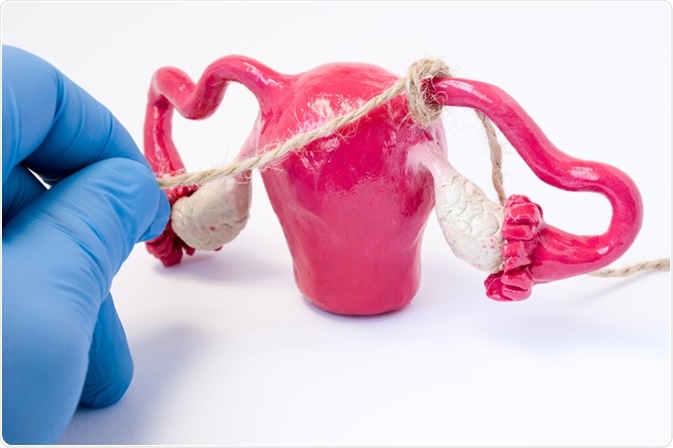Female sterilization is a widespread means of permanent contraception for women. There are different methods to achieve this, but the woman should always receive careful counseling to ensure she understands and is willing to accept the non-reversible nature of the procedure.
Considering all the techniques, female sterilization is 99 percent effective and may be performed post-partum (along with a Cesarean section) or when the woman is non-pregnant (termed interval sterilization). When compared to male sterilization, female sterilization is pursued three times more frequently.
 Image Credit: Shidlovski/Shutterstock.com
Image Credit: Shidlovski/Shutterstock.com
A variety of methods used for female sterilization
Electrocoagulation of the tube was the first method involved. Later, tubal ligation became popular. Other widely used techniques include using the Filshie clip, or bands, to achieve tubal obstruction. Fimbriectomy was another procedure adopted to reduce the possibility of post-sterilization pregnancy.
Female sterilization depends upon introducing a discontinuity into the fallopian tubes, thereby preventing contact between the oocytes and sperm, and subsequently, fertilization of the oocytes.
Tubal ligation
Tubal ligation involves transection of the tubes after ligating them on each side of the proposed division site. Sometimes the divided ends are sealed by electrocautery as well. Laparotomic or laparoscopic tubal ligation may be carried out by one of several ligation-excision methods.
Tubal ligation has shown to be highly effective, albeit the result may vary depending on the ligation method used and the patient’s race, ethnicity, and age. This method also confers protection against ovarian cancer and reduces the risk of pelvic inflammatory disease.
Tubal implant technique
Tubal implant is a technique that positions a tiny coil (Essure implant, a class III device) shaped like a spring into each tube, which induces scar formation, thereby blocking the cavity of the tube. This may take up to three months, during which backup contraception must be used. Confirmation of tubal obstruction is sometimes done by contrast radiography.
The coils are placed using a transcervical guide wire introduced by hysteroscopy through the vagina and uterus, which means there are no surgical incisions. I.e., it is a less invasive method to achieve permanent female sterilization.
The Essure implant was initially approved in 2002 based on prospective, non-randomized clinical trials. Since then, there was a substantial rise in device popularity, most notably in the US. However, from 2013 onwards, a sudden increase in the patient-reported adverse events related to this device has been observed.
In 2015, the US Food and Drug Administration (FDA) thoroughly reviewed the scientific literature, together with pre-marketing and post-marketing data, and concluded that insufficient evidence is available to withdraw this device from the market.
Still, the FDA released a new guidance document where (from now) a black box warning is required; a new postmarketing study to compare Essure’s efficacy and safety with laparoscopic tubal sterilization will be conducted.
Advantages and disadvantages of female sterilization
Female sterilization has several advantages when carried out properly. The ones that stand out are low rates of morbidity and mortality, permanent and effective contraception results, no need for male partner participation, and reduced incidence of ovarian cancer and PID (as already mentioned for tubal ligation).
Nevertheless, short- and long-term complications may occur following female sterilization. Short-term complications are mostly associated with tubal ligation and include infection, pain, and bleeding.
Long-term complications may also occur, most notably recanalization of the tube leading to pregnancy (either uterine or extrauterine), which occurs mostly in the first year following sterilization.
Post-sterilization regret, abdominal pain, dyspareunia (i.e., painful sexual intercourse), menstrual disturbances, and higher hysterectomy rates are also considered long-term complications. Other disadvantages include the lack of protection against sexually transmitted infections.
Failure rates
The efficacy of female sterilization is approximately 99 percent. Post-ligation rates are about 19 per 1000. Post-implant rates appear to be still lower. Spring-clip application rates are approximately 37 per 1000.
Failure of sterilization depends on patient selection, the chosen procedure, surgical skill, and the access route. Being a younger age may also play a role, as these women have increased fertility rates.
The highest rates of post-sterilization pregnancy are seen with a culdotomy approach – this is used in cases where an abdominal incision is not an option for tubal occlusion and is a more difficult procedure that requires a skilled gynecologic surgeon.
In contrast, the lowest rate of post-sterilization pregnancy is seen following thermal coagulation – an electrically safe procedure in which a low voltage is applied to cause division of the fallopian tubes.
Original article reviewed by Afsaneh Khetrapal, BSc (Hons)
Additional review and expansion by Tomislav Meštrović, MD, PhD
References
-
-
Gizzo, S. et al. (2014) "Female sterilization: Update on clinical efficacy, side effects and contraindications", Minimally Invasive Therapy & Allied Technologies, 23(5), pp. 261-270. doi: 10.3109/13645706.2014.901975.
-
Wallach, E., Huggins, G. and Sondheimer, S. (1984) "Complications of female sterilization: immediate and delayed", Fertility and Sterility, 41(3), pp. 337-355. doi: 10.1016/s0015-0282(16)47709-5.
-
J, N. and J, M. (1990) "Female sterilization: a review of methods, morbidity, failure rates and medicolegal aspects", Contemporary reviews in obstetrics and gynaecology, 2(3), p. Available at: https://pubmed.ncbi.nlm.nih.gov/12283859/ (Accessed: 6 September 2021).
-
-
Deborah Bartz, J. (2008) "Sterilization in the United States", Reviews in Obstetrics and Gynecology, 1(1), p. 23. Available at: https://www.ncbi.nlm.nih.gov/pmc/articles/PMC2492586/ (Accessed: 6 September 2021).
-
-
PMC, E. (2021) Europe PMC, Europepmc.org. Available at: http://europepmc.org/article/med/844970 (Accessed: 6 September 2021).
-
JE, G., JP, T. and T, G. (1979) "Laparoscopic tubal sterilization using thermal coagulation", Obstetrics and gynecology, 54(4), p. Available at: https://pubmed.ncbi.nlm.nih.gov/158718/ (Accessed: 6 September 2021).
-
Moss, C. and Isley, M. (2015) "Sterilization", Obstetrics and Gynecology Clinics of North America, 42(4), pp. 713-724. doi: 10.1016/j.ogc.2015.07.003.
-
Walter, J. et al. (2017) "Hysteroscopic Sterilization With Essure", Obstetrics & Gynecology, 129(1), pp. 10-19. doi: 10.1097/aog.0000000000001796.
Further Reading